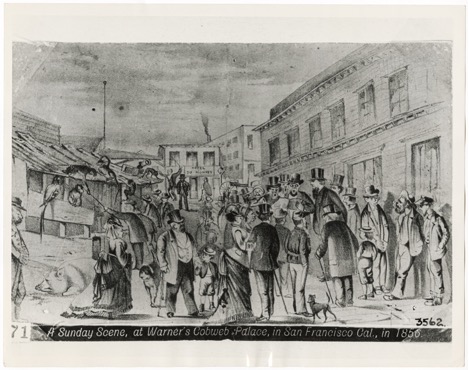The Monkeys and Parrots of Gold Rush-era California
Abstract
As immigrant gold miners migrated en masse to San Francisco and northern California during the Gold Rush-era (ca. 1849–1855), they experienced new animals. Stopping in ports throughout Central and South America, these argonauts saw, felt, smelled, heard, and occasionally consumed, mammals, birds, reptiles, and many more creatures, which were wholly exotic to those species found at home. Two types of animals that the Gold Rush populace encountered during this era include parrots and monkeys. Although found throughout tropical environments in areas far distant from northern California, these animals became quickly imported to San Francisco during the early 1850s. A wild, turbulent Gold Rush-era helped facilitate the importation of these exotic animal types, both for comfort and entertainment, as they helped provide a source of companionship for miners unaccustomed to the shock of 1850s northern California.
References
Bittner, M. 2007. The Wild Parrots of Telegraph Hill. Three Rivers Press, New York, NY.
Booker, M. M. 2006. Oyster Growers and Oyster Pirates in San Francisco Bay. Pacific Historical Review 75(1):63–88. DOI:10.1525/phr.2006.75.1.63.
Conrad, C. 2017. Kangaroos and the California Gold Rush. California History 94(3):62–65. DOI:10.1525/ch.2017.94.3.62.
Conrad, C. 2021. Compendium for the paper The Monkeys and Parrots of Gold Rush-era California. DOI:10.17605/OSF.IO/6Y7Q8.
Conrad, C., and A. Pastron. 2014. Galapagos Tortoises and Sea Turtles in Gold Rush-Era California. California History 91(2):20–39. DOI:10.1525/ch.2014.91.2.20.
Conrad, C., K. W. Gobalet, K. Bruner, and A. G. Pastron. 2015a. Hide, Tallow and Terrapin: Gold Rush–Era Zooarchaeology at Thompson’s Cove (CA-SFR-186H), San Francisco, California. International Journal of Historical Archaeology 19:502–551. DOI:10.1007/s10761-015-0297-2.
Conrad, C., L. Pagès Barceló, J. A. Seminoff, C. Turner Tomaszewicz, M. Labonte, B. M. Kemp, E. L. Jones, M. Stoyka, K. Bruner, and A. Pastron. 2018. Ancient DNA Analysis and Stable Isotope Ecology of Sea Turtles (Cheloniidae) from the Gold Rush-era (1850s) Eastern Pacific Ocean. Open Quaternary 4(1). DOI:10.5334/oq.41.
Daily Alta California. 1851b. Lost. Published on June 26, 1851.
Daily Alta California. 1851d. Recorder’s Court. Published on December 30, 1851.
Daily Alta California. 1852b. March of civilization. Published on January 26, 1852.
Daily Alta California. 1852f. Amusements. Published on June 13, 1852.
Daily Alta California. 1852g. Lost. Published on June 18, 1852.
Daily Alta California. 1853c. Importations. Published on March 15, 1853.
Delgado, J. 1996. To California by Sea: A Maritime History of the California Gold Rush. University of South Carolina Press, Columbia, SC.
Delgado, J. 2009. Gold Rush Port: The Maritime Archaeology of San Francisco’s Waterfront. University of California Press, Berkeley, CA.
Grier, K. C. 2006. Pets in America: A History. The University of North Carolina Press, Chapel Hill, NC.
Kennedy, J. R., L. Rogers, and F. A. Kaestle. 2018. Ancient DNA Evidence for the Regional Trade of Bear Paws by Chinese Diaspora Communities in 19th-Century Western North America. Journal of Archaeological Science 99:135–142. DOI:10.1016/j.jas.2018.09.005
Marysville Daily Herald. 1850b. Adventures in California. Published on September 13, 1850.
Praetzellis, M., and A. Praetzellis. 2009. South of Market: Historical Archaeology of 3 San Francisco Neighborhoods. Archaeological Studies Center, Rohnert Park, CA.
Sacramento Daily Union. 1854a. Musical. Published on January 30, 1854.
Sacramento Daily Union. 1854h. Street Scenes. Published on December 1, 1854.
Sacramento Transcript. 1851a. The Fair. Published on April 18, 1851.
San Francisco Call. 1892. The Cobweb Palace. Published on December 1, 1892.
San Joaquin Republican. 1852e. The Monkey and the Fox. Published on April 14, 1852.
Spencer, S., E. Decuypere, S. Aerts, and J. De Tavernier. 2006. History and Ethics of Keeping Pets: Comparison with Farm Animals. Journal of Agricultural and Environmental Ethics 19:17–25. DOI:10.1007/s10806-005-4379-8
Soulé, F., J. H. Gihon, and J. Nisbet. 1854. Annals of San Francisco. Appleton, New York, NY.
Stine, S. W. 1980. Hunting and the Faunal Landscape Subsistence and Commercial Venery in Early California. Unpublished Master’s Thesis, Department of Geography, University of California, Berkeley.
William Self Associates, Inc. 2019. Transbay Program, Final Archaeological Resources Report, Addressing Block 9 of the Transbay Redevelopment Project Area. William Self Associates, Inc., Orinda, CA.
Zierden, M. A., E. J. Reitz, B. Pavao-Zuckerman, L. J. Reitsema, and B. L. Manzano. 2019. What Is This Bird? The Quest to Identify Parrot Remains from the Heyward-Washington House, Charleston, South Carolina. Southeastern Archaeology 38(3):240–255. DOI:10.1080/0734578X.2018.1555407

Copyright (c) 2022 Cyler Conrad

This work is licensed under a Creative Commons Attribution-NonCommercial 4.0 International License.
Authors who publish with this journal agree to the following terms:
- Authors retain ownership of the copyright for their content and grant Ethnobiology Letters (the “Journal”) and the Society of Ethnobiology right of first publication. Authors and the Journal agree that Ethnobiology Letters will publish the article under the terms of the Creative Commons Attribution-NonCommercial 4.0 International Public License (CC BY-NC 4.0), which permits others to use, distribute, and reproduce the work non-commercially, provided the work's authorship and initial publication in this journal are properly cited.
- Authors are able to enter into separate, additional contractual arrangements for the non-exclusive distribution of the journal's published version of the work (e.g., post it to an institutional repository or publish it in a book), with an acknowledgement of its initial publication in this journal.
For any reuse or redistribution of a work, users must make clear the terms of the Creative Commons Attribution-NonCommercial 4.0 International Public License (CC BY-NC 4.0).
In publishing with Ethnobiology Letters corresponding authors certify that they are authorized by their co-authors to enter into these arrangements. They warrant, on behalf of themselves and their co-authors, that the content is original, has not been formally published, is not under consideration, and does not infringe any existing copyright or any other third party rights. They further warrant that the material contains no matter that is scandalous, obscene, libelous, or otherwise contrary to the law.
Corresponding authors will be given an opportunity to read and correct edited proofs, but if they fail to return such corrections by the date set by the editors, production and publication may proceed without the authors’ approval of the edited proofs.






